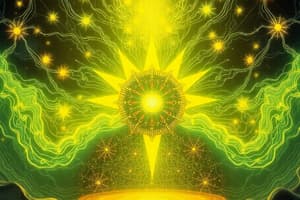Podcast
Questions and Answers
What is the main cause of magnetism?
What is the main cause of magnetism?
- The static position of electrons
- The temperature of the material
- The motion of electric charges (correct)
- The presence of gravitational fields
Which principle describes the conversion of electrical energy into mechanical energy in electric motors?
Which principle describes the conversion of electrical energy into mechanical energy in electric motors?
- The compression of a spring
- The expansion of gas within a cylinder
- The rotation of the rotor due to friction
- Electric current through a wire creates a magnetic field (correct)
Which of the following notable figures is credited with the discovery that electric currents create magnetic fields?
Which of the following notable figures is credited with the discovery that electric currents create magnetic fields?
- Michael Faraday
- Hans Christian Oersted (correct)
- James Clerk Maxwell
- Heinrich Hertz
What type of energy do electric motors primarily convert into mechanical energy?
What type of energy do electric motors primarily convert into mechanical energy?
What is the role of the commutator in DC generators?
What is the role of the commutator in DC generators?
Which type of generator uses falling water to turn turbines?
Which type of generator uses falling water to turn turbines?
What phenomenon did James Clerk Maxwell propose regarding light?
What phenomenon did James Clerk Maxwell propose regarding light?
What component in an electric motor helps keep the rotor spinning in one direction?
What component in an electric motor helps keep the rotor spinning in one direction?
Flashcards
Electricity
Electricity
A form of energy produced by moving electrons.
Magnetism
Magnetism
The force exerted by magnets when they attract or repel each other.
Electromagnetic Waves
Electromagnetic Waves
Disturbances in electric and magnetic fields that transfer energy.
Electric Motor
Electric Motor
Signup and view all the flashcards
Electric Generator
Electric Generator
Signup and view all the flashcards
Force
Force
Signup and view all the flashcards
Electromagnetic Induction
Electromagnetic Induction
Signup and view all the flashcards
Electromagnetic Spectrum
Electromagnetic Spectrum
Signup and view all the flashcards
Study Notes
Electricity & Magnetism
- Electricity is a type of energy that results from the movement of electrons.
- Magnetism is a force exerted by magnets when they attract or repel each other. This force is caused by the motion of electric charges.
- Like charges repel; unlike charges attract.
Force
- Force is an external agent that changes a body's state of rest or motion.
- Force fields include gravitational, electric, and magnetic fields.
Electromagnetic Waves
- Electromagnetic waves are disturbances in electric and magnetic fields that transfer energy through space.
Notable Figures in Electromagnetism
- Hans Christian Oersted: Discovered that electric currents create magnetic fields.
- Michael Faraday: Developed the First Law of Electromagnetic Induction.
- James Clerk Maxwell: Proposed that light is an electromagnetic phenomenon.
- Heinrich Hertz: Proved the existence of electromagnetic waves.
Electric Motors
- Electric motors convert electrical energy into mechanical energy.
- The principle is that an electric current through a wire creates a magnetic field.
- When surrounded by magnets, a rod (part of the motor) rotates due to attractive and repulsive forces.
Types of Generators
- Hydropower uses falling water to turn turbines.
- Wind uses wind to turn blades and generate electricity.
- Fossil fuel/steam burns fuel to create steam, turning turbines.
Components of DC Generators
- Stator provides magnetic fields for the coil to spin.
- Rotor contains slotted iron laminations to reduce Eddy Current losses.
- Commutator converts AC to DC voltage.
- Brushes transfer current from the commutator.
- Shaft transfers mechanical energy to the generator.
Types of Electric Motors
- Permanent magnets line the motor casing.
- Rotor is a copper wire coil that spins when a current flows.
- Commutator reverses current to keep the rotor spinning in one direction.
Comparison: Motors and Generators
- Motors:
- Input: Electrical energy
- Output: Mechanical energy
- Generators:
- Input: Mechanical energy
- Output: Electrical energy
Studying That Suits You
Use AI to generate personalized quizzes and flashcards to suit your learning preferences.




